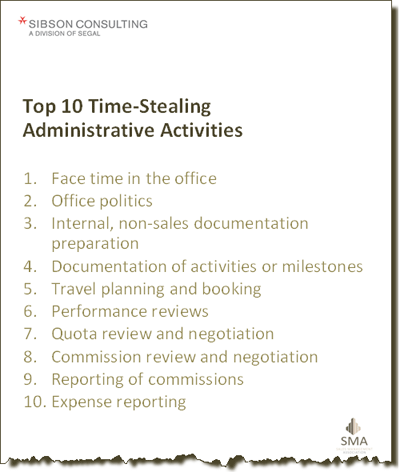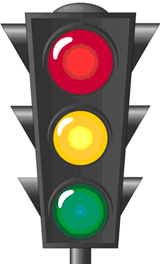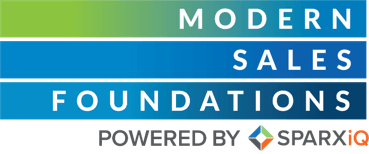If you are a sales leader responsible for salespeople, you no doubt make decisions on what gets implemented in the sales organization with their best interest in mind. New sales processes, programs, initiatives – many are valuable; but many burden your salespeople unnecessarily. Each new idea and request can effectively reduce the time salespeople spend on key responsibilities, contaminating their sales routine with mundane or non-revenue producing activities.
This “contamination” from non-productive activity is a major reason many sales people underperform. And too often, the source of contamination can be traced to sales management.
Using recent client research, Sibson Consulting’s Joe DiMisa takes a closer look at sales forces’ most prevalent productivity-wasting activities. The included “Decontamination Assessment” tool provides management with a blueprint for reducing administrative burdens and increasing sales force productivity.
When new processes, programs, and systems start flowing, sales managers may think they are helping their sales people. In fact, if you are a senior sales executive or an executive of any kind with a sizable sales force, you too may think your organizational and process decisions are in the best interest of the organization. While some of these mandates are no doubt valuable, many are not and may burden your sales people unnecessarily. Each new idea and request can effectively reduce the time reps spend on key responsibilities, contaminating their sales routine with mundane or non-revenue producing activities.
On an average day, almost half of the messages clicking across a sales rep’s Blackberry originate from the rep’s management, or so a rep told me recently. Take yesterday as an example: By 9AM, the rep had fielded messages about sales process refinements, new time reporting requirements, commission adjustments, meeting requests, product re-introductions, orientation of recent hires, travel restrictions, expense reimbursement, and the introduction of a new performance management system. Each of these required a response, some demanded completing forms, follow-up phone tag, and even several meetings. “It takes its toll,†the rep confided, “Admin time is down time where sales are concerned, but I spend way too many hours reconfiguring my work week to fit the new proclamations from above. It cuts into my selling time for sure.â€
Contamination from non-productive activity is a major reason many sales people under perform on their sales goals. And too often, the source of contamination can be traced to you and your sales managers.
A Closer Look at Time-Stealing Activities
A sales rep’s clock registers two types of time: selling time and non-selling time, characterized by the following activities:
-
Selling time is spent on direct customer contact or general sales planning. Direct customer contact includes face-to-face meetings, entertainment, or telephone conversations. General selling comprises account planning, developing other business, or resolving customer issues.
-
Non-selling time is spent on activities not directly related to customers or prospects. This includes administrative tasks, internal meetings, training, travel, or other non-selling functions that do not involve direct contact or direct support of a customer or prospect.
Average performing sales reps usually waste effort on non-productive non-selling activities, particularly administration, which steals time from actual selling. Top sales performers typically are more adept at dealing with the administrative demands their bosses make, and they focus their time or efforts on disciplined actions that lead to sales.
In fact, a recent Sibson Consulting productivity study shows that average-performing sales reps spend only about 35 percent of their time in direct selling, but devote a whopping 65 percent to administrative, non-selling activities. In contrast, high-performing reps allocate the majority of their time—55 percent—to selling (see Exhibit 1)
A closer look at the time clock reveals that many of those non-selling activities are management-generated, particularly the myriad demands for reports and documentation (See Exhibit 2). Certainly, reports and documentation are important—how else can management check in and check up on their team? Yet, they sap time and energy. And the reality is that mounting administrative requirements give inexperienced reps and average performers an excuse to divert time from sales activities.
Exhibit 1: Use of Daily Work Time by Sales Personnel
| Activities | Average Performers | Top Performers |
| Selling Time. Includes customer contact, other selling activities. | 35% | 55% |
| Non-Selling Time. Administrative tasks, internal meetings, training, travel, or other non-selling functions that do not involve direct contact or direct support of a customer or prospect. Typically these are attributable to managers mandating that salespeople perform these activities. | 65% | 45% |
| Source: Sibson Consulting 2006 survey of 1,200 sales personnel at 60 major technology and telecom companies | ||
A closer look at the time clock reveals that many of those non-selling activities are management-generated, particularly the myriad demands for reports and documentation (See Exhibit 2). Certainly, reports and documentation are important—how else can management check in and check up on their team? Yet, they sap time and energy. And the reality is that mounting administrative requirements give inexperienced reps and average performers an excuse to divert time from sales activities.
Managers looking to decontaminate time within their sales team may want to study the habits of top performers. They can pass those best practices on to the broader team and, as importantly, start adjusting their own management style to curb requests that add to the administrative load.
How High Performers Free Up Time
Why do top performers have more sales time and less administrative time? Overall, they spend more time planning early in their sales process, and do not chase as many bad deals. Consequently, they avoid the administrative burden bad deals create. At other stages of the sales process, they strive for efficiency, resulting in less need for separate documentation and manager reviews.
Top performers work between 15 to 18 percent more hours in a week and spend those hours in selling activities. When faced with unscheduled pockets of time, top performers use that time effectively. They work on becoming a better account manager or industry expert. They engage in activities that drive interest in their product or service. They realize that those unclaimed hours between sales calls can be the best time to look for new opportunities, visit an old client, or get to know a potential new one. When their managers demand more face time, new reporting schemes, or training on the latest sales reporting tool, they comply efficiently, often downloading tasks to others. Top performers are more adept at leveraging their sales team to complete non-selling tasks. They use administrative assistants effectively for reporting, and delegate sales-related tasks, e.g., prospecting, industry research, to junior sales staff.
Exhibit 2: Top Ten Time-Stealing Administrative Activities

Top reps also have an ally in their managers. It is not unusual for managers to award time “perks†to top performers: High-performing reps often receive more help from their sales team and administrative support to free up their time and sharpen their focus. Managers place more trust in their top performers, and thus require less follow-up. Stellar results create less need for conversation, so performance reviews are quicker too. Perhaps counterproductively, managers spend most of their time with lower-performing reps. While coaching may be appropriate, it takes even more time away from the sales process.
Top performers spend significantly less time in the sales office. They consider time in the office to be distracting and non-productive. In the course of a visit, they may pick up unwanted tasks or administrative burdens, so they prefer to steer clear. When they do visit, they take advantage of office reviews to hear of opportunities or gain ideas, thus turning some of that administrative down time into sales time.
Finally, top performers may ignore some administrative activities that revolve around proving their value…they realize the value is in their sales results. There’s no need to keep clicking that incentive calculator—they know they’re above and beyond quota.
Apply the Decontamination Index
To help determine if you or your organization is wasting your sales reps’ time, take three minutes to complete a simple self assessment around time-sensitive activities. The minutes spent assessing your habits may add valuable hours to your sales team’s day.
Step 1: The Decontamination Assessment
Take the “Decontamination Assessment†by filling in the number of hours that a typical rep spends attending to activities that are not associated with direct selling and customer contact.
THE DECONTAMINATION ASSESSMENT
| Non-Selling Activity Per Sales Representative | Average Hours a Rep Spends on the Activity in a Typical Week | ||
| 0 – 1 | 2 – 3 | 4 – 5+ | |
| 1. “Face time†in the office: If direct sales reps are not located in a group office, how many hours is a rep required, or encouraged, to spend in the office each week regardless of their client schedule | |||
| 2. Documentation: How much time does a rep spend either documenting their own sales or non-sales activities, or creating burdensome documentation for non-selling functions, e.g., sending emails and correspondence to non-sales groups like IT, HR or Marketing | |||
| 3. Travel planning and booking: How much time does a rep spend planning and booking upcoming travel | |||
| 4. Performance reviews: How much time does a rep spend reviewing and discussing either their own or others’ individual performance with you or other managers, team leaders, or coaches? This is time outside of the selling process, i.e., not on a ride-along. | |||
| 5. Quotas and commissions: How much time does a rep spend discussing, negotiating, reporting, tracking and/or calculating their quotas and commissions | |||
| 6. Sale implementation: How much time does a rep spend on internal post-sale follow-through to expedite product or service delivery and resolve issues | |||
| 7. Expense reporting: How much time does a rep spend organizing, reporting, calculating, and following up on expenses | |||
| Total Hours | |||
Step 2: The Decontamination Index
Add up the total number of hours spent per week on non-selling activities and determine where the total number falls in the “Decontamination Index.â€
DECONTAMINATION INDEX
| Total Hours Per Week Spent on Non-Selling Activities | Assessment | |
| Red Zone 20 hours or more |
 |
Decontaminate Now: You are likely losing significant sales given the amount of time reps waste not selling. Â Your organization is burdening reps with activities that take away from their ability to properly service their customers. Â Your organization should determine if your sales process and administrative processes are properly managed. |
| Yellow Zone 10 hours to less than 20 |
Contamination Creep: Contamination is creeping into your sales force.  Your reps are wasting time on non-selling activities.  You are missing opportunities to generate maximum sales results due to your internal policies and procedures.  Identify the key areas that are creating the issue and work to off-load these “sales time killers.†| |
| Green Zone 0 hours to less than 10 |
Efficient and Productive: Congratulations! You and your managers have a culture and support processes in place to ensure reps spend the majority of their time on sales-critical activities. Â You are most likely focused on your customers vs. your own internal policies. Â Keep an eye on any activities that push you to the upper limit of this zone. | |
Step 3: Decontaminate
Too many hours spent in the non-sales administrative functions will push the sales organization into the yellow or red zone. These are hours that contribute to missed opportunities. Review your Decontamination Assessment scores to see what individual activities are creating the problem thus reducing the most sales time. To make an immediate impact, you do not necessarily need to focus on all the activities, you can take a systematic approach by determining which are either the easiest to fix or are wasting the greatest amount of time. Identify the top two to three “time contaminates†and set a goal to eradicate them within the quarter, if not sooner.
Look to your top performers to see how they avoid these time wasters. Above all, rein in the need for more information and determine what and how reps are being asked to report. Engage sales management in continuous monitoring to ensure they are not allowing these activities to “creep†back in to the equation. Use spot awards and other reward opportunities to get the sales force out of the contamination zone and into channeling energy into productive, sales-oriented actions. Just be sure to keep all actions simple and constructive with a goal of removing the burden, not adding to it.
About The Author

Joseph DiMisa is Senior Vice president, Sibson Consulting, The Segal Company. As leader of Sibson’s Sales & Marketing practice, Mr. DiMisa works with leading companies to develop and implement sales strategies and sales effectiveness programs that drive profitable growth. He specializes in the design and implementation of sales management solutions to increase sales and profits for clients.
Mr. DiMisa frequently writes for and has been featured in a number of well-known business periodicals. Mr. DiMisa’s management book on the principles of selling, entitled “A Fisherman’s Guide to Selling,†was released in early 2007 and is featured in many sales centric business associations and is classified as a business best seller. He also speaks frequently on best practices and strategies for optimizing sales channel performance, and is generally recognized as an expert in sales planning and design. He can be reached at 770-403-8006 or [email protected].









